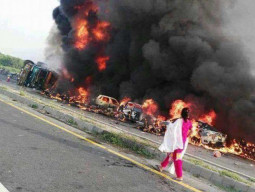
Upon last count, over 164 innocent lives had been extinguished prematurely in the deadly oil tanker tragedy in Bahawalpur. Such a colossal incident should serve as an eye-opener and an introspection to address issues which could prevent unnecessary morbidity and mortality.
The Bahawalpur tragedy should serve to highlight the dismal state of healthcare in our country. Health, as a whole, remains a highly neglected topic. Statistically speaking, Pakistan has 0.8 physicians per 1,000 people, while it is 2.5 for America, 2.5 for Saudi Arabia and 1.4 for Iran. For hospital beds, the numbers paint an equally stark picture. The number is 0.6 for Pakistan, 2.9 for America and 2.1 for Saudi Arabia. Pakistan lacks both the providers as well as the places which provide healthcare.
The victims of the Bahawalpur tragedy succumbed to burn injuries and I will use this space to highlight the deficiencies in burn care services in Punjab. There are a total of 23 teaching and 36 district headquarters hospitals all over Punjab, but only six of them reportedly have public burns units: Nishtar Hospital in Multan, Allied Hospital in Faisalabad, Holy Family Hospital in Rawalpindi and the Mayo, Jinnah and Services Hospital in Lahore. So essentially, for a population projected at 101 million, there are just these six facilities which in the past have also had questions raised upon them as well.
Victoria Hospital in Bahawalpur is a 1,600-bed, fully equipped, tertiary care hospital with major medical and surgical specialties, affiliated as a major teaching hospital for undergraduate and postgraduate specialty training. However, what is glaringly missing is a burns unit.
Burn victims are not just emotionally challenging, but medically very taxing as well. However, there has been a remarkable progress in care for burn victims with the development of the science of burn care. This includes precise management scenarios for fluid, electrolyte and nutritional support, prevention of infections and establishment of dedicated burn units which help in providing highly specialised medicinal and nursing care. Without dedicated personnel and space, the battle against burns is a lost cause.
After the incident happened, the severely injured were afflicted with extensive burn injuries. Timing is of the essence here, as burn victims need to be treated immediately and effectively. Hence, it comes as no surprise that a major chunk of the critically injured who was transferred for Multan for specialised care succumbed to their injuries. Multan is almost 100km from Bahawalpur by road and for the critically burnt a distance which meant it was already too late by the time they reached Nishtar Hospital.
Research from Pakistan has shown that there is a significant burn problem which the country faces, with scald and flame burns being the most common cause of such injuries. Even prior to this tragedy, there have been multiple instances where there has been a demand put forward for more burn centres in Punjab and Pakistan as a whole.
Ironically, when I was researching for this piece, I stumbled upon a newspaper article from June 19th when the local notables of Bahawalpur were advocating for the establishment of a burns unit at Victoria Hospital. Supposedly, there had been completion of a PC-1 for the suggested burn unit and the process was under way to release funds of Rs500 million for implementation for the unit. Alas, tragedy struck too soon.
The Bahawalpur tragedy serves as a stark reminder of how much still needs to be accomplished in Shahbaz Sharif’s province, which prides itself on progress. It is commendable indeed that in Punjab’s latest budget, the budget for primary and secondary health for 2017-18 has been allocated at Rs111 billion, as opposed to Rs66 billion last year. However, there is so much disparity and so much that needs to be done that even this increase seems paltry.
The Punjab government needs to devise mechanisms on how it can optimally utilise their allotted resources to address the issue of burn care.
Published in The Express Tribune, June 30th, 2017.
Like Opinion & Editorial on Facebook, follow @ETOpEd on Twitter to receive all updates on all our daily pieces.





















































COMMENTS (1)
Comments are moderated and generally will be posted if they are on-topic and not abusive.
For more information, please see our Comments FAQ